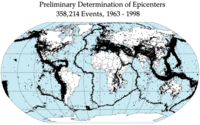
Photo from wikipedia
Abstract The relationship between intraslab seismicity and the dynamics of subduction is a subject of ongoing debate. Uncertainty surrounds (1) the extent to which the stress regime associated with slab… Click to show full abstract
Abstract The relationship between intraslab seismicity and the dynamics of subduction is a subject of ongoing debate. Uncertainty surrounds (1) the extent to which the stress regime associated with slab earthquakes reflects the driving/resisting forces of subduction, or more localised processes such as metamorphic or thermo-elastic volume change, and (2) the relative contribution of uniform (stretching/shortening) and flexural (bending/buckling) deformation modes in slabs. Because variations in slab curvature are very clear in subduction zones with flat slab segments, such settings allow for assessment of the relationship between slab geometry, bending and seismicity. Using a numerical model that reproduces published flat slab geometries we show how bending rates, which are dominated by the advective component, relate to downdip curvature gradients. Based on published slab geometries, we show that the patterns of seismicity in the Peruvian and Mexican flat slabs, vary systematically with slab curvature gradient. Seismicity is restricted to regions colder than about 600 °C. This means that only the upper half of flat slab bending zones are expressed seismically, providing the appearance of a uniform extensional regime.
Journal Title: Earth and Planetary Science Letters
Year Published: 2019
Link to full text (if available)
Share on Social Media: Sign Up to like & get
recommendations!